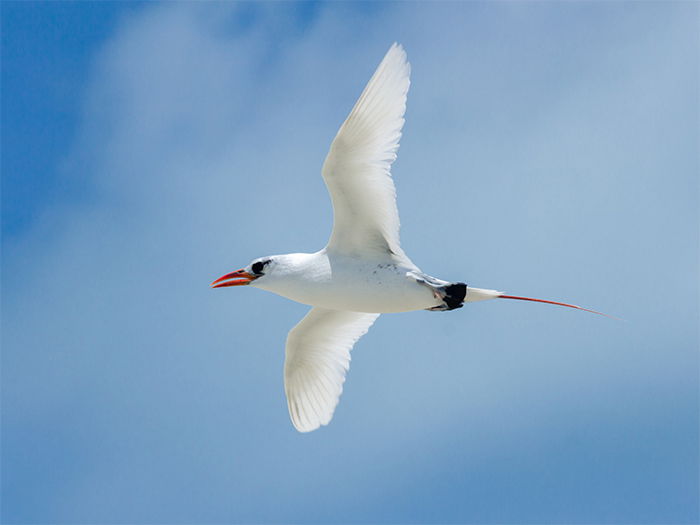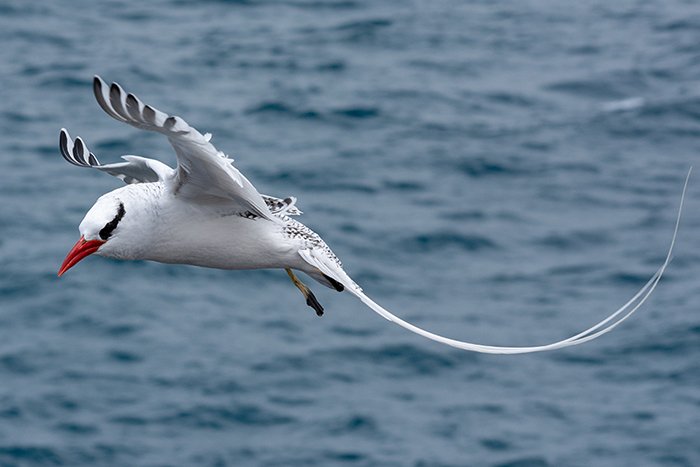Break Out the Binoculars
Dominic Sherony, CC BY-SA 2.0 https://creativecommons.org/licenses/by-sa/2.0, via Wikimedia Commons
Phaethontidae
by Inspector Barry Mins on February 22, 2022Hey kids, welcome back to our series on the mysteries of created kinds!
Last week we looked for a large rodent found throughout the world. This week we need to break out the binoculars because we’re looking for seabirds today.

These seabirds are found in most of the world. Much of what is known about them relates to their nesting behavior. One species uses its feet to transfer heat from its body to its eggs to incubate them.1 The eggs make tasty snacks for rats, mongooses, crabs, and other predatory species.2,3,4 Because the eggs and chicks make tasty treats, the adults tend to breed on isolated islands and steep cliffs to stay clear of predators.5 Nests are generally relatively close to one another, usually within ten yards of each other.6

ericdalecreative, CC BY-SA 4.0 https://creativecommons.org/licenses/by-sa/4.0, via Wikimedia Commons
The parents feed the young mostly fish and squid.7 Most of these prey are caught relatively close to the surface of the water, though a few dives reached over 80 feet!8 The young will hatch after approximately 41 days and fledge after roughly 73.9 The most likely location of the nest is a cavity in the rocks, ideally one including sand.10

Nicolas Völcker via Wikimedia Commons
Has anyone figured it out yet? This week’s kind is the Phaethontidae, also known as the tropicbirds. These white seabirds are found worldwide in the tropics. Ironically, the biggest threat to these birds is last week’s kind, the Muridae, which happen to enjoy their eggs and chicks. Next week we head to southeast Asia to look for another bird.
Try out this fun crossword puzzle!
Clue
Your clue for the week is:
This bird prefers running to flying and is quite shy, with a call that can switch between a long low whistle and a sound similar to a frog.
Footnotes
- Colleen T. Downs, Lorinda A. Hart, and M. Brown, “Hot footing eggs: thermal imaging reveals foot mediated incubation in White-tailed Tropicbirds, Phaethon lepturus,” Journal of Ornithology 157 (2016): 635-640.
- G.R. Leal, P.P. Serafini, I. Simao-Neto, R.J. Ladle, and M.A. Efe, “Breeding of White-tailed Tropicbirds (Phaethon lepturus) in the western South Atlantic,” Brazilian Journal of Biology 76, no. 3 (2016): 559-567.
- Raissa Sarmento, Daniel Brito, Richard James Ladle, Gustavo da Rosa Leal, and Marcio Amorim Efe, “Invasive house (Rattus rattus) and brown rats (Rattus norvegicus) threaten the viability of red-billed tropicbird (Phaethon aethereus) in Abrolhos National Park, Brazil,” Tropical Conservation Science 7, no. 4 (2014): 614-627.
- Marcelo Flores, Pedro Lazo, Graciela Campbell, and Alejandro Simeone, “Breeding status of the Red-tailed Tropicbird (Phaethon rubricauda) and threats to its conservation on Easter Island (Rapa Nui),” Pacific Science 71, no. 2 (2017): 149-160.
- Eric A. Vanderwerf and Lindsay C. Young, “Breeding biology of red-tailed tropicbirds Phaethon rubricauda and response to predator control on O’Ahu, Hawai’I,” Marine Ornithology 42 (2014): 73-76.
- Fred Charles Schaffner, “Nest-site selection and nesting success of white-tailed tropicbirds (Phaeton lepturus) at Cayo Luis Pena, Puerto Rico,” The Auk 108 (1991): 911-922.
- M. Le Corre, Y. Cherel, F. Lagarde, H. Lormee, and P. Jouventin, “Seasonal and inter-annual variation in the feeding ecology of a tropical oceanic seabird, the red-tailed tropicbird Phaethon rubricauda,” Marine Ecology Progress Series 255 (2003): 289-301.
- Julia Sommerfeld and Janos C. Hennicke, “Comparison of trip duration, activity pattern and diving behaviour by Red-tailed Tropicbirds (Phaethon rubricauda) during incubation and chick-rearing,” Emu 110 (2010): 78-86.
- Schaffner, "Nesting Tropicbirds,” 913.
- Miguel A. Mejas, David B. Wingate, Jeremy L. Madeiros, Yolanda F. Wiersma, and Gregory J. Robertson, “Nest-cavity selection and nesting success of Bermudian white-tailed tropicbirds (Phaethon lepturus catesbyi),” The Wilson Journal of Ornithology 129, no. 3 (2017): 586-599.
- © 2024 Answers in Genesis
- Privacy Policy
- Contact
- About
